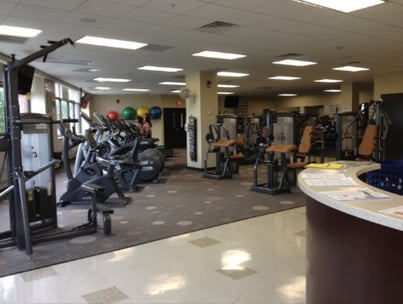 This has been the year of design and consulting work for senior living clients who are renovating or building new fitness centers. I think I could give you the dimensions of a NuStep T4r model in my sleep (they are 60 x 27 x 24 inches, by the way). It truly is exciting to see the industry dedicating resources to well-designed fitness spaces to support quality programs and services for residents.
This has been the year of design and consulting work for senior living clients who are renovating or building new fitness centers. I think I could give you the dimensions of a NuStep T4r model in my sleep (they are 60 x 27 x 24 inches, by the way). It truly is exciting to see the industry dedicating resources to well-designed fitness spaces to support quality programs and services for residents.
Although getting the right equipment and layout is important, these five design elements come up time and time again and should be considered early in the planning process. They might not be the same level of financial investment as your large equipment purchases, but they can significantly enhance your users’ experience and the program’s success.
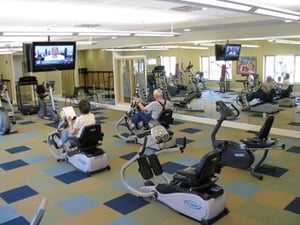 Televisions and entertainment: Determine whether you will pursue wall-mount televisions or the integrated console option on the cardio machines. With some equipment like NuSteps and rowers not having the integrated TV option, you will want a wall-mount TV somewhere in your facility. With wall-mount TVs you’ll have to navigate the channel wars for the lifelong battle between Fox News, CNN, and MSNBC, which individuals have VERY strong preferences for—imagine that! Consider an FM tuner option with headphones if needed, but we generally see residents politely following the first-come, first-served rule.
Televisions and entertainment: Determine whether you will pursue wall-mount televisions or the integrated console option on the cardio machines. With some equipment like NuSteps and rowers not having the integrated TV option, you will want a wall-mount TV somewhere in your facility. With wall-mount TVs you’ll have to navigate the channel wars for the lifelong battle between Fox News, CNN, and MSNBC, which individuals have VERY strong preferences for—imagine that! Consider an FM tuner option with headphones if needed, but we generally see residents politely following the first-come, first-served rule.- Water source: Don’t forget to dedicate space for a water fountain or hydration station in the fitness center and where group fitness classes are held, or within immediate proximity. It’s highly important to encourage hydration during exercise. The more conveniently located the water source, the better.
- Balance training area: When designing a fitness center, most think of cardio equipment, strength equipment, and then a stretching area. Don’t forget about an area dedicated to balance training. This can be as simple as a wall with a handrail and a balance pad. A balance training area can be one of the busiest spots in your fitness center—particularly if you have qualified staffing to provide fall-prevention programming.
- Mirrored walls: Coaching residents on how to perform exercises in front of a mirror can make a significant impact on reinforcing proper form and posture. This can be especially important in group fitness spaces or in areas of the fitness center where residents might be performing balance, resistance band, or dumbbell exercises.
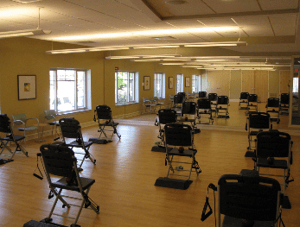 Exercise chairs: We are big fans of the Resistance Chair for exercise classes, but if you are using traditional chairs, consider these specifications to make them more exercise-friendly. Armrests can be obstructive to a number of upper-body exercises, limiting a participant’s range of motion. Choosing an option without armrests or a slimmer armrest option is ideal. Also consider the height and weight of the chair; many chairs are used as a stable base of support and serve as a handle during standing exercises. Consider a chair with a taller backrest that can help residents maintain a tall, upright posture while performing exercises.
Exercise chairs: We are big fans of the Resistance Chair for exercise classes, but if you are using traditional chairs, consider these specifications to make them more exercise-friendly. Armrests can be obstructive to a number of upper-body exercises, limiting a participant’s range of motion. Choosing an option without armrests or a slimmer armrest option is ideal. Also consider the height and weight of the chair; many chairs are used as a stable base of support and serve as a handle during standing exercises. Consider a chair with a taller backrest that can help residents maintain a tall, upright posture while performing exercises.
These minor details can make a big impact on the functionality of the space and programming options. We have designed dozens of senior living fitness centers and take these things and much more into consideration when creating the most functional and comfortable space for residents. Check out NIFS’ Senior Living Wellness Consulting page for more insight into how we support fitness center design projects across the country.

.jpg?width=404&name=GettyImages-1132973672%20(1).jpg) Fitness Fads vs. Classic Methods
Fitness Fads vs. Classic Methods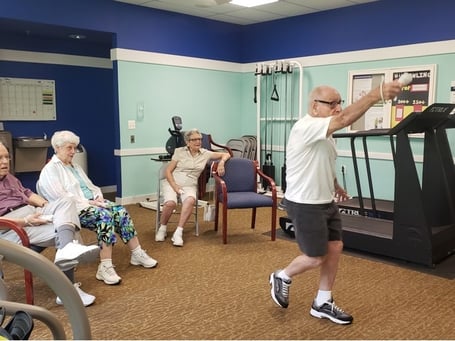 This summer, teams all around the country ironed their bowling shirts, warmed up their throwing arms, and double-checked their TV connections in preparation for the first-ever 10-week session of the NIFS Wii Bowling League.
This summer, teams all around the country ironed their bowling shirts, warmed up their throwing arms, and double-checked their TV connections in preparation for the first-ever 10-week session of the NIFS Wii Bowling League.
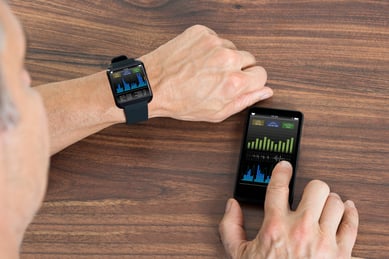 Considering how long it can take to make a global shift in corporate America, the rise of wearable fitness trackers in wellness has been meteoric. A recent study reports an anticipated
Considering how long it can take to make a global shift in corporate America, the rise of wearable fitness trackers in wellness has been meteoric. A recent study reports an anticipated 
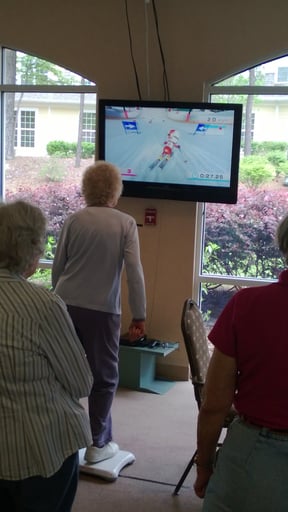 Twenty years ago, if someone had suggested purchasing video games for a retirement community, they would have been laughed at. “Those are for kids,” would have been the response. “No one over 60 is ever going to be interested in that.” I’m here to tell you times have changed! Now, everywhere you look people of all ages are getting in on the action and testing their skills in the virtual world.
Twenty years ago, if someone had suggested purchasing video games for a retirement community, they would have been laughed at. “Those are for kids,” would have been the response. “No one over 60 is ever going to be interested in that.” I’m here to tell you times have changed! Now, everywhere you look people of all ages are getting in on the action and testing their skills in the virtual world.
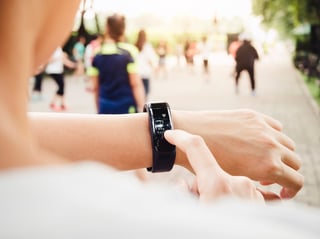 Every year the
Every year the 
 There’s been a lot in the media lately about wearable technology having a strong presence in corporate wellness. Employee wellness programs have
There’s been a lot in the media lately about wearable technology having a strong presence in corporate wellness. Employee wellness programs have 
 In the world of technology, time equals improvement and efficiency. Back in the day, we had computers that occupied the space of an entire room and Zack Morris-sized cell phones. Now we have personal computers that fit in the palm of a hand and Zoolander-sized cell phones. It seems that as more is discovered in the world of technology, items have become smaller and more efficient. Interestingly enough, this concept does not seem to apply to people.
In the world of technology, time equals improvement and efficiency. Back in the day, we had computers that occupied the space of an entire room and Zack Morris-sized cell phones. Now we have personal computers that fit in the palm of a hand and Zoolander-sized cell phones. It seems that as more is discovered in the world of technology, items have become smaller and more efficient. Interestingly enough, this concept does not seem to apply to people. As the first wave of baby boomers are turning 65 this year, there is a rush to the finish line in the technology field to see who can come up with the best ideas to keep elders healthy, happy, and in their own homes.
As the first wave of baby boomers are turning 65 this year, there is a rush to the finish line in the technology field to see who can come up with the best ideas to keep elders healthy, happy, and in their own homes.